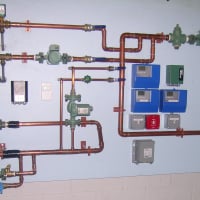Best Of
Re: Air to Water Heat Pump - Ever installed or used one? Need advice and recommendations
Arctic Heat Pumps spent a lot of money to try and bring in R290. They played by the rules. In the end we brought in another High Temp Heat Pump. Arctic spent a lot of money to get legal approval for our Two Stage High Temp Heat Pump. It received UL listing
It is just unfair for Apollo to spend nothing on these approvals bringing in an illegal product and take market share from the many companies selling legal heat pumps in America.
Also I read there recent Apollo adds. Good till -31f? SCOP 4.88? I would ask to see verification of those claims to. You just can't trust them.
Re: Air to Water Heat Pump - Ever installed or used one? Need advice and recommendations
My comments were in response to a post by Prevch.
Re: Air to Water Heat Pump - Ever installed or used one? Need advice and recommendations
I got one of these:
Cost was good and with local support. R32 EVI, low temp performance is decent but still need to design for low SWT.
I recently saw the LG R32 monoblocs for sale. Much better low temp capacity maintance and COP. Not cheap though:
 Kaos
Kaos
Re: Return changes elevation and other oddities.
I happen to have a few small 3/4" F&Ts that are in great shape but for failed thermostatics. A Tunstall capsule and some gasket material and we're good. I really appreciate all the guidance.
Re: Air to Water Heat Pump - Ever installed or used one? Need advice and recommendations
Efficiency Vermont has a list of all air-to-water heat pumps being sold in the US:
In your climate you want something with vapor injection for cold weather performance. You can pretty much tell by comparing the column with the 5F capacity with the nominal capacity, with vapor injection it will be close to 90% and without it will be 50-75%.
Re: How do you know your boiler is done for? And how do you plan for replacement?
How big is a box? Actually, that's a good life for a boiler — but a well cared for one, particularly an older one, can last longer than that. Sometimes a lot longer. On the other hand, a more modern, more efficient boiler — with lighter and thinner castings — operating on poorer water quality, or with leaks in the system, may only last half as long.
Re: How do you know your boiler is done for? And how do you plan for replacement?
Steam. You're in luck… it's rare for a boiler to fail catastrophically (piping can, but rarely a boiler). Usually they will give you some warning — sometimes a lot of warning — and what you will see is an increase in water usage. You may also see steam escaping from the chimney.
Now this isn't really good — but the good news is that steam systems can run on absurdly low pressure, so even if you are losing a lot of water and the leak is really gross, you can still run the old thing and get enough time to organise a replacement.
You don't really want to do that if the leak is from the steam side to the boiler room — the humidity can do some damage — but even then it's not an instant no heat situation.
Now you can evaluate what size boiler you need pretty much any time, at your leisure. That's because steam boilers are sized to match the connected radiation, and that — usually — isn't going to change. So take some time any time and write down what you have for radiators and their ratings and add them up.
Replacing a boiler is an excellent time to work on odd piping — but keep in mind that all steam boilers have a recommended minimum piping arrangement for the near boiler piping, so you are really only concerned about weird things elsewhere.
It doesn't hurt to establish a relationship with a good steam boiler man in advance. You need one anyway, to maintain what you have correctly. Might as well start now… but there's no need to get a quote on a replacement until you need one. Prices — and available equipment — just change too fast.
Re: We Got Steam Heat - wish I never read this book
I have a question on how they did it? How did they get sufficient duct size through 2x4 walls? 3 1/2 x 14 1/2 is probably good for a single vent. They would have needed to open up all the walls on the first floor………….to get to the second floor…………???
The basement probably needed 20" x 20" mains…………….???
Re: HPWH, learning curve
If your attic is over 145F you could just put a tank up there, no need for heating it.


